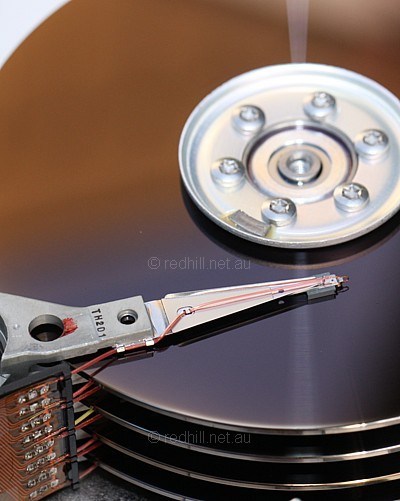
Fujitsu M2614ET (172MB, 1992).
Update your bookmark
This is the old site. You probably want the new site.
The new site has all the same information but adds more drives, updated text, and much better pictures of many models.
- Micropolis 2217
- Seagate Medalist 545xe
- Western Digital AC2540
- Seagate Decathlon 545
- IBM DALA-3540
- Seagate Medalist 720
- Seagate ST-3544A
- Seagate Medalist 630xe
- Western Digital AC2850
- Seagate Medalist 1080
- Seagate Decathlon 850
- Seagate Decathlon 851
- IBM Deskstar XP
- Fujitsu M1614
This old version of the Red Hill guide hasn't been updated for ten years. The new version can be found here.
It's hard for old-timers to get used to calling drives this big 'small', but by comparison with the 80 and 160GB monsters now on the shelf, these 540MB and 1.7GB drives are, well, tiny. But many of them remained perfectly sensible choices for business and light-duty home use right up past the end of the century.
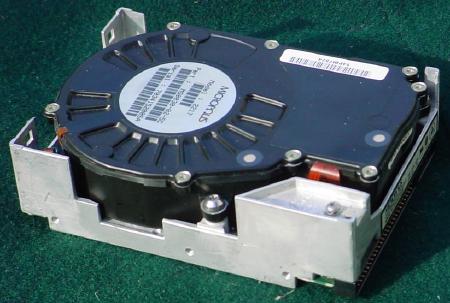
Micropolis 2217
Back in late '93 or '94 when we bought one of these for our own office, it was state of the art, about as fast as hard drives could go. The biggest IDE drive on the market then was 545MB. The 1.7GB 2217 cost almost $2000, or about as much as a Seagate Cheetah did in '97 or a pair of X15-36LPs do now. It gave excellent service for a good long while but by the time mainstream drives had reached into the 2 and 3GB range in '97 it was showing its age. Almost any newish IDE drive would out-perform it by then.
When you look at the long-term cost-benefit, for the first year we had a much bigger and faster drive than was possible any other way, for the second year we had much the same performance as we'd have got from the best IDE drives, by the third year, we could have replaced it with a faster and cheaper IDE drive at a fraction of the cost. In fact, that's exactly what we did. We used it for archival storage for a few years longer, on a task where reliability was more important than speed.
But reliability wasn't Micropolis' strong point by this time. They had once earned an enviable reputation for quality, but by the time they made the 2217s they were struggling financially and their quality was dropping off. We had damaged our 2217 (our fault — not theirs) when it was about two years old and to our delight they replaced the drive for us. Alas, the replacement drive was nowhere near as good as the original had been, and it decayed rapidly. By the time we thought to get it replaced again, Micropolis had gone bankrupt. The next time we spent a four figure sum on a hard drive, we would do what we should have done in the first place: go to the best SCSI maker of them all, Seagate.
| Performance | 0.85 | ||
| Data rate | 46.5 Mbit/sec | Spin rate | 5400 RPM |
| Seek time | 10ms | Buffer | 512k |
| Platter capacity | 240MB | Interface | Fast SCSI 2 |
| Actuator | voice coil | Form | 3½" 1/2 height> |
| 2217 | 1.765GB | 15 thin-film heads | * |
1994 Drive of the Year
Seagate Medalist 545xe
The immortal Seagate 545. We sold more of these drives than any other model, before or since, and we were still selling them as trade-ins for years afterwards. The ST-3660 remained in production almost forever.
Up until the drive capacity-growth explosion at the turn of the century, over time a manufacturer would normally end up having three or four models for any given size range. Their first drive of that size would be an expensive six or eight-head state of the art drive, the biggest and fastest thing they could make at the time; then (as the technology matured) a cheaper four-head, mid-volume model would replace it; after that (as the market began to expect that size of drive as standard) there would be a low-cost four-head model which sold in massive numbers. Finally, there might be a very low cost single platter (two head) unit to gather the last few sales before the market moved on to the next size up.
But the ST-3660 was different. It was one of the first 500MB drives to sell in significant numbers, and with proven reliability and moderate cost it just kept on going and going. Seagate never needed to replace it (the later Seagate 540MB ST-3544A was a re-badged Conner drive). At 3800 RPM and 14ms it was never a speed-king, but always respectable. Cheap, reliable, simple to set up and very compatible, quick enough in its day — if we had a Drive of the Decade award, this drive would win it.
| Performance | 0.66 | Reliability | AA1 |
| Data rate | 35.8 Mbit/sec | Spin rate | 3811 RPM |
| Seek time | 14ms | Buffer | 120k |
| Platter capacity | 272.7MB | Encoding | RLL |
| Form | 3½" 1/3 height | Interface | IDE mode 3 |
| ST-3660 | 545.5MB | 4 thin-film heads | ***** |
Western Digital Caviar AC2540
Up until this drive, we had been keen Western Digital buyers here at Red Hill. We sold a lot of the Caviar 40, 80, 120, 240, 345 and 420MB drives, and had excellent results with them. The AC2540 was certainly very fast for the times, but we had quite a high failure rate with them. To make matters worse, these were a very big drive and rather expensive (most people were buying 170 or 210MB drives at the time) so they only went into our very best machines — not the ones you want to have falling over with hard drive problems!
At the time we thought that WD had tried to push the performance envelope a little bit too far and ended up sacrificing reliability to do it. Looking back, that may have been true, or maybe we just had a run of bad luck with them. Either way, this was when we started our long and very happy relationship with Seagate. We still bought Western Digitals from time to time for the next five years or so, and were usually happy with them, but until about 2000 we always seemed to end up coming back to Seagate as our number one brand.
| Estimated performance | 0.77 | Reliability | AA3 |
| Estimated data rate | 38 Mbit/sec | Spin rate | 4500 RPM |
| Seek time | 12ms | Buffer | 64k |
| Platter capacity | 270MB | Interface | IDE mode 3 |
| Actuator | voice coil | Form | 3½" 1/3 height> |
| AC2540 | 540.8MB | 4 thin-film heads | * |
Seagate Decathlon 545
The ST5660A was the first Decathlon, a name that would become famous not too much later on. As with all the Decathlon drives, it came in an unusual, slim-line form — but unlike its younger, bigger brothers it was a 4500 RPM unit. Nevertheless, it was noticeably faster than other drives available at the time. Notice the first digit of the model number. As always with Seagate drives, the "5" indicates a slimline drive, where a "3" is a standard half or third-height unit.
| Performance | 0.78 | Reliability | AA1 |
| Data rate | 48 Mbit/sec | Spin rate | 4500 RPM |
| Seek time | 12ms | Buffer | 256k |
| Platter capacity | 273MB | Encoding | RLL |
| Form | 3½ slimline | Interface | IDE mode 3 |
| ST-5660A | 545.5MB | 4 thin film heads | ** |
Seagate Medalist 720
The first Seagate drive to break the 540MB barrier, and probably the worst Seagate drive since their infamous souped-up 40MB RLL models way back in the mid-Eighties. The return rate on these was very high. When the Seagate and Western Digital 850s came out, we dropped it like a hot potato.
| Performance | 0.77 | Reliability | BA |
| Data rate | 47.2 Mbit/sec | Spin rate | 4500 RPM |
| Seek time | 12ms | Buffer | 256k |
| Platter capacity | 360MB | Encoding | RLL |
| Form | 3½" 1/3 height | Interface | IDE mode 4 |
| ST-3780A | 720.2MB | 4 thin film heads | ** |
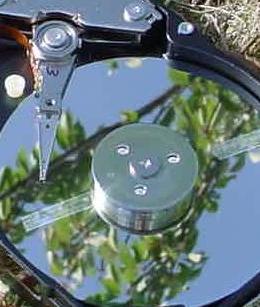
IBM DALA-3540
These were an excellent little drive; very fast for a 500, as reliable as sunrise, and delightfully easy to work with. They were the only 500MB drive we ever sold in preference to the bulletproof Medalist 545. (We sold other 500MB-class drives besides these two, of course, but only when we couldn't get stock of one or other of them.)
By the time these arrived, 500MB was entry-level and the higher-spec systems were shipping with larger drives, so most of our DALAs went into budget-oriented 486DX/2s and DX/4s which, thanks to the excellent drive, remained useful longer than might have been expected otherwise.
The DALA-350 was also the first mass-market drive to feature Magneto-Resistive head technology, and had only a single platter — very unusual in a 540MB drive. As you can see from the illustration at left, there was ample room inside the HDA to put a second platter, but so far as we know IBM never brought out a 1.08GB version — perhaps because LBA addressing was not yet in full swing, or perhaps because IBM just didn't see a market for it. There was a 540MB platter 1GB IBM drive around this time or just a little later, the Deskstar XP, but it was quite different looking and a 5400 RPM model.
For quite a few years we wanted to open one up and see for ourselves. Naturally, doing this destroys the drive so normally we'd just wait till the warranty period had expired and do it to a failed one, but with the DALAs we had to wait a long, long time before we finally came across a dead one. It is very unusual to see one of these in anything else but perfect working order.
| Performance | 0.78 | Reliability | AAA |
| Data rate | 49 Mbit/sec | Spin rate | 4500 RPM |
| Seek time | 12ms | Buffer | 64k |
| Platter capacity | 270MB | Encoding | RLL |
| Form | 3½" 1/3 height | Interface | IDE mode 3 |
| DALA-3540 | 540.8MB | 2 MR heads | **** |
Seagate (Conner) ST-3544A
These re-named Conner drives finally saw off the venerable ST-3660. They sold in reasonable numbers for a short while right at the end of the 500MB era. They were fast for a 540, simple to set up by Conner standards (which is not saying much!), cheap, and reliable — in short, an almost perfect entry-level drive.
| Performance | 0.77 | Reliability | AA1 |
| Data rate | 46 Mbit/sec | Spin rate | 4500 RPM |
| Seek time | 12ms | Buffer | 256k |
| Platter capacity | 270MB | Encoding | RLL |
| Form | 3½" 1/3 height | Interface | IDE mode 3 |
| ST-3544A | 540.9MB | 4 thin film heads | *** |
Seagate Medalist 630xe
This was an updated version of the Medalist 545 which appeared for a short while just as the 545 was discontinued. (Sometimes we thought the faithful old performer would never die!) By this time, they were getting sluggish at 14ms and 3800 RPM, but the Medalist 630 was very cheap and came from a line of drives with an outstanding record for reliability. Later on there was an 850MB version too, but we only ever saw a couple of them. By that time, they were starting to seem very slow.
| Performance | 0.68 | Reliability | AA2 |
| Data rate | 39.6 Mbit/sec | Spin rate | 3811 RPM |
| Seek time | 14ms | Buffer | 120k |
| Platter capacity | 315MB | Encoding | RLL |
| Form | 3½" 1/3 height | Interface | IDE mode 3 |
| ST-3630A | 631.1MB | 4 thin film heads | ** |
Western Digital Caviar AC2850
Our second choice 850MB drive, and no shame in that — these were one of the great drives: firmly in the tradition of the famous Western Digitals of 80MB and 210MB days. The Caviar 850 was an excellent substitute for the 850MB Decathlons when the Seagate drives were out of stock, particularly during the two-month gap between the end of the 5850A and the first of the new model ST-5851A. The Western Digital 850 was not only quick, it proved to be very reliable and many of them were still in service for years to come. For its size it remains a worthy drive even now.
As with many Western Digital units, these always seemed faster in real life than the raw specs suggested. The reason for this remains debatable: some claim that it was better cache optimisation in the firmware, others that it was their ability to perform particularly fast short seeks.
Our main showroom demo computer ran plenty fast enough with one right up until early 1998, and we still traded them in eagerly and resold them happily until early in the new century.
| Performance | 0.80 | Reliability | AA1 |
| Data rate | 42.1 Mbit/sec | Spin rate | 4500 RPM |
| Seek time | 10ms | Buffer | 64k |
| Platter capacity | 427MB | Encoding | RLL |
| Form | 3½" 1/3 height | Interface | IDE mode 3 |
| AC-2850 | 853.6MB | 4 thin film heads | *** |

Seagate Medalist 1080
A close relative of the unlamented 720MB Medalist, but this one was a decent drive, and quite quick in its day. Notice the cache; 256k was huge by the standards of the time. The ST31220 was one of the very first drives in this 1GB size range, quite a bit in advance of the Conner Cabos below, and almost unique in its ability to be hardware split — by setting a jumper on the logic board, you could make it emulate two 500MB drives in master/slave mode. This was very useful for motherboards that didn't support LBA addressing, and indeed the only way to fit a large drive to a non-LBA main board outside of the ever-dubious boot sector device drivers, such as Ontrack Disk Mangler ... er ... I think we meant to say Disk Manager.
By the way, this was just about the last Seagate drive to use a model number indicating its unformatted capacity — all the more recent Seagates use the more logical formatted capacity. The "ST3" indicates Seagate 3.5 inch third height, the "A" ATA or IDE, the number in-between is the capacity. Western Digital use a very similar scheme: an AC31600, for example, is an ATA Caviar ("AC") with three discs (five or six heads), storing 1.6GB.
We never sold the related ST5540A: it came much later on and was a single platter version of the Decathlon 1080. By the time these arrived, performance-conscious buyers wanted 1GB or 1.2GB drives.
| Performance | 0.77 | Reliability | AA2 |
| Data rate | 47.2 Mbit/sec | Spin rate | 4500 RPM |
| Seek time | 12ms | Buffer | 256k |
| Platter capacity | 360MB | Encoding | RLL |
| Form | 3½ slimline | Interface | IDE mode 4 |
| ST31220A | 1.08GB | 6 thin film heads | ** |
1995 Drive of the Year
Seagate Decathlon 850
One of the all-time great hard drives. The Decathlon 850 was the fastest IDE hard drive in the world for a long, long time. They were very small, very cute, and very, very fast.
The Decathlon drives were designed as high-end, high-performance products. With their unusual double-sided circuit board, they were quite expensive to manufacture. But because Seagate had left themselves without a bread and butter drive in this size class, they either had to sacrifice their hard-earned market share, or sell these premium drives at mass-market prices. That they did, and we sold truckloads of them.
Like the Medalist 1080, the Decathlon had a dual-drive emulation jumper. We still used to see quite a few Decathlons in working machines up until close to the end of the century, and even today they remain a useful item.
Picture: three 850MB Decathlons with a pair of full-size Conner drives for comparison (upper background). Notice how much smaller the Decathlons are, and how crude they make the Conners look. This is no illusion: by this time the ever increasing standards set by Seagate, IBM, Western Digital and Quantum had begun to make Conner and Maxtor drives look very crude. Both companies were to find themselves in financial difficulties before too much longer.
| Performance | 0.88 | Reliability | AAA |
| Data rate | 61.7 Mbit/sec | Spin rate | 5376 RPM |
| Seek time | 11ms | Buffer | 256k |
| Platter capacity | 427MB | Encoding | RLL |
| Form | 3½" slimline | Interface | IDE mode 4 |
| ST5850A | 854.7MB | 4 thin-film heads | ***** |
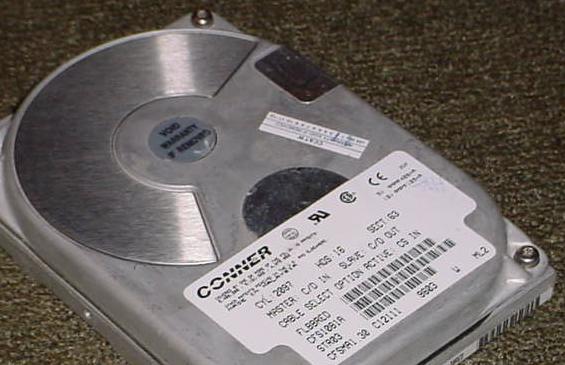
Conner (Seagate) Cabo Family
The Cabo 1275 was one of the very first 1.2GB drives to reach the market, and a typical Conner: stolid and rather slow. There was nothing much else in this size range when these first appeared.
The smaller 1.08GB Cabo appeared a little later, and it was another poor effort: despite higher areal density it was not much faster than the 1275 and had an un-Conner like high failure rate too. We never liked them much but were more or less forced to use them at the time because the industry was going through one of its periodic shortage phases, and drives were very hard to get. There were plenty of these on the grey market with only 12 month warranties — but even this was better than no drives at all!
Later on we also had a handful of the 1.6GB Cabos. The distributors always had stocks of these even when they had run out of everything else in the size range — probably because these were so expensive and so slow for a 1.6GB drive!
Compare the Conner 1.6 to the contemporary IBM Deskstar 1.7 and Seagate Medalist 4500 1.7GB drives below, and the Conner 1081 and 1275 to the Medalist SLs. Conner were past their great days by this time and their drives were falling well off the pace. Before too long Seagate bought the company, mainly to get access to Conner's huge modern disc manufacturing facilities (and to keep Samsung from buying their way into the top tier!) and the more recently manufactured Cabos had Seagate badging.
Pictured above: the unlovely Conner CFS1081A.
| Performance | 0.74 | Reliability | AA2 |
| Data rate | 54.9 Mbit/sec | Spin rate | 3600 RPM |
| Seek time | 14ms | Buffer | 64k |
| Platter capacity | 425MB | Encoding | RLL |
| Form | 3½ half height | Interface | IDE mode 4 |
| CFS1275A | 1.275GB | 6 thin film heads | *** |
| Performance | 0.77 | Reliability | AA3 |
| Data rate | 65.2 Mbit/sec | Spin rate | 3600 RPM |
| Seek time | 14ms | Buffer | 64k |
| Platter capacity | 540MB | Encoding | RLL |
| Form | 3½ half height | Interface | IDE mode 4 |
| CFS1081A | 1.08GB | 4 thin film heads | ** |
| CFS1621A | 1.62GB | 4 thin film heads | * |
Seagate Decathlon 851
The Decathlon 850 went end of life while it was still a very popular drive, and with no real successor announced. For Seagate, it just cost too much to make. Here at Red Hill we switched to the Western Digital Caviar 850 as the next best thing (though Quantum were starting to make some excellent drives at this time too). Then came the good news: Seagate had released a new Decathlon. This one, the ST5851, was cheaper to make. It had a single-sided circuit board and 128k rather than the generous 256k cache of the older drive, but the faster media transfer rate made up for that. If anything, the new Decathlon was even faster than the old. And just like the previous model, it was a huge success.
| Performance | 0.91 | Reliability | AAA |
| Data rate | 67.7 Mbit/sec | Spin rate | 5376 RPM |
| Seek time | 10.5ms | Buffer | 128k |
| Platter capacity | 427MB | Encoding | RLL |
| Form | 3½ slimline | Interface | IDE mode 4 |
| ST5851A | 845.7MB | 4 thin film heads | ***** |
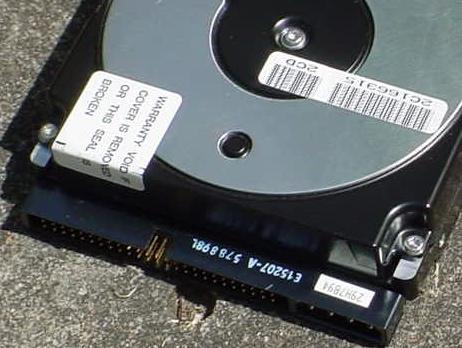
IBM Deskstar XP
We could never decide whether we liked this drive or the Seagate Decathlon 1080 better — so we stocked them both, side by side: something a retailer almost never does. The two drives had very similar specifications, were very close to equal in speed — the IBM being better in the flesh than the raw specs would indicate — and either one made an excellent choice. By the smallest of margins, we tended to favour the Decathlon for performance (because of its then-new IDE Mode 4 interface), and, in another hair-line decision, the Deskstar for mission-critical tasks — though the Decathlon 1080 was by no means fragile.
Over the years these proved to be one of the two or three most reliable drives we had ever seen. Out of several hundreds of them, we returned none at all in the first year, and just one (or was it two?) during the entire warranty period. That is not so unusual these days — Samsung do it as routine — but it is still not something one can just expect as of right, and it was very unusual back then.
There was a SCSI version of the Deskstar XP too. We bought a pair of DPES 1GB SCSI drives for our main server in 1996. They both ran 24 hours a day, 365 days a year until about the end of 2002 (swapped to a less performance-critical machine by then, of course) and one of them remains in service to this day (July 2005), playing music in the Red Hill workshop. It ain't broke, so why mend it?
| Performance | 0.87 | Reliability | AAA |
| Data rate | 55 Mbit/sec | Spin rate | 5400 RPM |
| Seek time | 10.5ms | Buffer | 512k |
| Platter capacity | 540MB | Encoding | RLL |
| Form | 3½ half height | Interface | IDE mode 3 |
| DPEA-31080 | 1.08GB | 4 MR heads | **** (IDE) |
| DPES-31080 | 1.08GB | 4 MR heads | * (SCSI) |
Fujitsu M1614
As typical an example as any of the Fujitsu drives we were to come to dislike intensely over the next few years. They were instantly recognisable, even inside a sealed case, by the soft, sweet sound they made — not unlike that of the old Kyocera KC-20 — and probably the quietest drives of any from this era.
They seemed to be reliable enough and were probably quite cheap (we never sold any new, so can't speak with certainty about their pricing), but they were horribly slow: fit for comparison only with the notorious Quantum Bigfoot.
This was why we soon came to hate that sweet little Fujitsu peeping sound. The moment a system came into the workshop and you heard it, you immediately knew that no matter what you did to the system — upgrade the RAM, swap the CPU, wipe the operating system off and reinstall — short of actually replacing the hard drive it would remain obstinately sluggish and unpleasant to use. In an earlier entry we mentioned that nearly all Western Digital drives of this era were faster in real life than the specs would indicate. The corresponding Fujitsu drives, from this one on to around about the 6 or 10GB period, were the opposite. Thankfully, they didn't have terribly good distribution in Australia and were not all that common.
Adding insult to injury, one of those trivial matters that gets under your skin. The model numbering, of these and of almost all the later Fujitsus, made no sense whatever. How on earth were you supposed to be able to work out that an M1614TAU was a 1.09GB drive but the MPF3102AT was a 10GB unit without looking the model numbers up? Still, at least they marked them with a manufacturing date, something that not enough drive makers do. This one left the factory in July 1996.
| Performance | 0.83 | Reliability | AAX |
| Claimed data rate | 63 Mbit/sec | Spin rate | 4500 RPM |
| Seek time | 12ms | Buffer | 64k |
| Platter capacity | 540MB | Encoding | PRML |
| Form | 3½ half height | Interface | IDE mode 4 |
| M1612TAU | 545MBGB | 2 TF heads | |
| M1614TAU | 1.09GB | 4 TF heads |

Maxtor 71336
A drive from Maxtor's darkest days, the period when they were faced with bankruptcy and were selling all their assets to stave off the bankers — even their production facilities. Eventually, they sold the entire company to Hyundai, or what remained of it.
Maxtor's drives, once such immaculately presented products, now looked cheap and nasty, and though we had long since switched to other brands, we saw quite a few third party systems come to have faulty Maxtor drives replaced. Price wise they were very competitive, but when a firm has so little else to boast about that it is reduced to selling on price alone, its future is usually grim.
→ Maxtor 71336 with late-model 5x86 main board. Notice the power connector which, for some unexplained reason, on Maxtor drives was always mounted upside down. This one is an AP model with the larger 128k cache and was manufactured on 30th May 1996.
Under Hyundai's new management, Maxtor would eventually recover; Hyundai was able to sell off its Maxtor stock at a tidy profit some years later, and after what was probably the most remarkable back-from-the-dead experience the storage industry has ever seen, Maxtor merged with Quantum to become the biggest hard drive manufacturer in the world.
| Performance | 0.84 | Reliability | AA3 |
| Data rate | 65 Mbit/sec | Spin rate | 4480 RPM |
| Seek time | 12ms | Buffer | 64k or 128k) |
| Platter capacity | 670MB | Encoding | RLL |
| Form | 3½ half height | Interface | IDE mode 4 |
| 7668 | 668MB | 2 TF heads | |
| 71336 | 1.34GB | 4 TF heads | |
| 71670 | 1.67GB | 5 TF heads | |
| 72004 | 2.0GB | 6 TF heads |
Seagate Medalist SL (Decathlon) Family
Seagate's Decathlon 850 had been one of the outstanding drives of the mid-nineties. At the time of its introduction it was the fastest IDE hard drive in the world. Only the equally excellent Quantum Fireballs were in the same league, and the Decathlon 850/851 twins kept their speed crown for month after month. The 850 rapidly became our best-selling drive, and remained a favourite right up until Seagate replaced it with these two slightly larger-capacity models, the Decathlon 1080 (which is illustrated above) and soon after that, the Medalist SL 1270. (The 'SL' stands for slim line and indicates a thinner than usual drive.) Typical of the best of Seagate drives, these were super-fast and just about bullet-proof too. It was only at the end of the century that they stopped being a very saleable trade-in.
We never sold the related ST5540A new: this smaller version of the Decathlon 1080 was a little too late for the market: by that time performance-conscious buyers wanted 1GB or 1.2GB drives, and 500MB class drives, as the smallest drives always do, sold only on price.
The well-known names "Fireball" and "Decathlon" were the mark of a top-quality drive with outstanding performance. Both are meaningless now. Within the next few years Quantum devalued the Fireball name by calling all its IDE drives Fireballs (fast or not), while Seagate went the other way and stopped using the Decathlon name at all. The then-new ST-51270 was introduced as the Medalist SL 1270, and the ST-5180 Decathlon was renamed in mid life. Seagate's 1998 range of 7200 RPM drives, which was as much an advance on the current technology as the Decathlons had been in their day, was simply the "Medalist 7200". There are too many finance-department bean counters in the big drive companies today, and not enough product guys.
| Performance | 0.91 | Reliability | AAA |
| Data rate | 67.7 Mbit/sec | Spin rate | 5376 RPM |
| Seek time | 10.5ms | Buffer | 128k |
| Platter capacity | 542MB | Encoding | RLL |
| Form | 3½" slimline | Interface | IDE mode 4 |
| ST-51080A | 1.08GB | 4 thin-film heads | ***** |
| ST-5540A | 541.9MB | 2 thin-film heads |
| Performance | 0.92 | Reliability | AA1 |
| Data rate | 71.4 Mbit/sec | Spin rate | 5376 RPM |
| Seek time | 10.5ms | Buffer | 128k |
| Platter capacity | 641MB | Encoding | RLL |
| Form | 3½" slimline | Interface | IDE mode 4 |
| ST-51270A | 1.282GB | 4 thin-film heads | **** |
1996 Drive of the Year
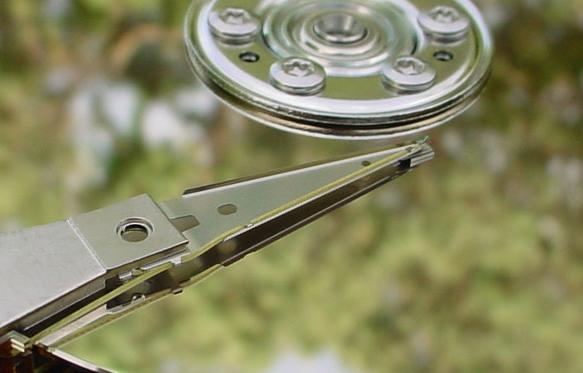
IBM Deskstar 2
These magnificent drives were an instructive example of IBM's great strength throughout the nineties, leading-edge technology. The four advanced Magneto-Resistive heads read and wrote more data per square inch than any other drive on the market. In turn, this resulted in the highest data transfer rate around, and at a surprisingly low cost.
Best of all, the Deskstar 2s proved to be one of the three or four most reliable drives we had ever had in service. Their only flaw was IBM's occasional habit of running right out of stock without telling anyone first. (This drives retailers to distraction.)
We sold 1.7GB Deskstars by the bucket-load: to high-end buyers because of their performance, to budget buyers because of their low cost per MB, and to mission-critical buyers because of their reliability. As the best drive of the year, they were the only possible choice.
| Performance | 0.88 | Reliability | AAA |
| Data rate | 62.1Mbit/sec | Spin rate | 4500 RPM |
| Seek time | 10ms | Buffer | 96k |
| Platter capacity | 850MB | Encoding | RLL? |
| Form | 3½" 1/3 height | Interface | IDE mode 4 |
| DJAA-31270 | 1.27GB | 3 MR heads | |
| DJAA-31700 | 1.7GB | 4 MR heads | ***** |
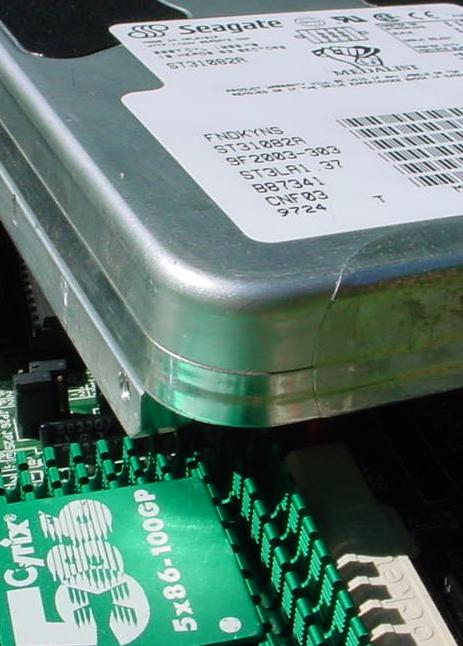
Seagate Medalist 1276 and 1082
A pair of Conner-flavoured Seagates, not particularly fast by the standards of the time, but solid and very cost-effective.
As so often with Seagate's lower-end drives, these had a long market life. They arrived about the time that the Medalist SL disappeared and soldiered on until nearly everything else was substantially bigger and faster.
Anything less than 3GB was by then regarded as entry-level, where speed was less an issue than cost. This meant that traded-in drives in this size range could often be faster than new ones — something that tends not to be true these days. This is one of the reasons why, back when redhill.net.au was more of a buying guide rather than a simple trip down memory lane, we always used to mix old and new drives together here. If you simply wanted reliable storage at reasonable cost, an entry-level new drive like the Medalist 1276 was an excellent choice. If you wanted maximum performance in this size range, it was better to look for an older high-performance premium drive that had been traded-in: something like the Medalist SL above.
The 1.08GB Medalist 1082 was almost a twin of the Medalist 1276 but a little older, smaller, and slower. Like the 1276 it was a one-time best-seller that remained common as a trade-in up until about 1999. When they were new we put a lot of these into entry-level budget systems and network terminals, where they gave long and faithful service.
→ Illustration: a very common combination in the mid-nineties, Medalist 1082 with Chaintech 486SPM main board and Cyrix 5x86-100 CPU.
| Performance | 0.78 | Reliability | AA1 |
| Data rate | 67.7 Mbit/sec | Spin rate | 4500 RPM |
| Seek time | 10.5ms | Buffer | 128k |
| Platter capacity | 516MB | Encoding | RLL |
| Form | 3½" slimline | Interface | IDE mode 4 |
| ST31082A | 1.08GB | 4 thin-film heads | **** |
| Performance | 0.83 | Reliability | AA1 |
| Data rate | 71.4 Mbit/sec | Spin rate | 5376 RPM |
| Seek time | 10.5ms | Buffer | 128k |
| Platter capacity | 641MB | Encoding | RLL |
| Form | 3½" half-height | Interface | IDE mode 4 |
| ST31276A | 1.282GB | 4 thin-film heads | **** |
Seagate ST-32140
The first ever IDE drive over 2GB, long awaited and keenly anticipated. These days, since about 1997 or '98, capacity is no longer an issue, as almost any normal use is amply provided for by a single cheap and readily available drive. This was not so in earlier years, and power users with (for example) twin 1.08GB drives and no room for expansion would put their names down on a waiting list for the first shipment of each new release. (Back then, remember, most systems had just a single IDE controller, so adding more drives was not a realistic option — if you were that keen, you blew a month's wages on a SCSI setup — and CD burners were not yet a practical reality.)
The wait for a 2GB drive seemed even longer than usual, with none of the manufacturers able to stretch traditional IDE products to that capacity. Eventually, Seagate took the existing 2.1GB Hawk SCSI drive (a pretty high-end product at the time) and adapted it to use an IDE interface. Despite a strong early showing, the ST-32140 had a short market life — they were fairly expensive to manufacture — and it quickly gave way to more advanced drives with late-nineties features like MR heads, PRML read channels and much higher areal density. In their time, though, these were the biggest, fastest drives money could buy.
| Performance | 0.93 | Reliability | AA1 |
| Data rate | 67.7 Mbit/sec | Spin rate | 5376 RPM |
| Seek time | 10ms | Buffer | 128k |
| Platter capacity | 502MB | Encoding | RLL |
| Form | 3½" slimline | Interface | IDE mode 4 |
| ST32140A | 2.11GB | 8 thin-film heads | ** |
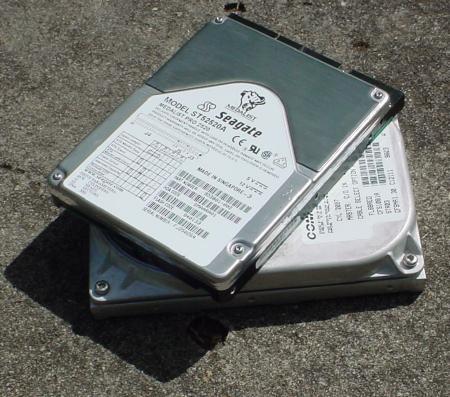
Seagate Medalist Pro
These tiny, beautifully finished drives were very, very fast — just as you'd expect from Seagate's slim-line Decathlon heritage. Compare with the bulky and crude looking Conner below (a drive of roughly equal vintage). They were noticeably faster even than the IBM Deskstar 3 range, and that made the Medalist Pro 2520 the fastest IDE drive in the world at that time.
The technology was mind-blowing: MR heads, PRML read channel, and a mere two platters to store 2.5GB.
Unfortunately, the 2520 had a disturbingly high failure rate, always with the same fault: sustained re-seeking causing a massive drop in performance. (Five minutes to boot Windows, sometimes more.) Thankfully, it was one of the very rare hard drive faults that do not result in data loss: a couple of hours in the workshop and we'd have the data transferred to a new drive with a minimum of fuss. Seagate addressed the problem eventually, but before then we switched to the slower and more dependable Quantum Fireball TM 2.5GB drive, and then the superb 3.2GB IBM Deskstar 3.
The much bigger but otherwise similar ST36450 didn't seem to suffer from this problem. We only sold six or eight, as they were one of the first 6GB drives available and quite expensive, but they all performed flawlessly and we continued to sell them in their updated Ultra-ATA form (ST36451). From late 1997 on, we switched to newer 6GB drives, mostly the IBM Deskstar 5 and the Western Digital AC36400.
| Performance | 1.01 | Reliability | BA |
| Data rate | 116 Mbit/sec | Spin rate | 5397 RPM |
| Seek time | 11ms | Buffer | 128k |
| Platter capacity | 1.28MB | Encoding | PRML |
| Form | 3½" slimline | Interface | IDE mode 4 |
| ST52520A | 2.56GB | 4 MR heads | *** |
Seagate Medalist 1720 and 2531
Another pair of drives from the Conner half of Seagate; they combined Seagate speed with the Conner look and feel. (Including, unfortunately, the traditional Conner fetish for having odd-ball jumper settings.)
High areal density made them surprisingly fast for 4500 RPM units (notice the relatively high internal data rate), and they had the usual excellent Seagate reliability. These had a very long market life; the 1.7 in particular saw out two or three generations of other drives and sold well throughout its career. Notice how these typical value-for-money drives had similar performance to the previous year's high-speed premium drives (like the Deskstar 1.7 and the Medalist SL 1.28 above).
The Medalist 1722 was essentially the same as the 1720 but with ATA-33 support. There was a reasonably well-publicised compatibility problem between some early revisions of the 1720 and early-model motherboards using the then-new 3 volt chipsets like the Intel TX and the SiS 5591. We hardly ever saw it for ourselves though, perhaps because we were never big fans of the TX anyway.
The 2.5GB ST32531 was very similar drive to the Medalist 1.7, but with six heads rather than four. As with all the Medalist 4500 range, it was designed as a reliable, low-cost drive with only moderate performance. It was about $20 cheaper than a higher performance 2GB drive, and $20 more than its primary competitor, the still slower Quantum Bigfoot.
| Performance | 0.89 | Reliability | AAA |
| Data rate | 88 Mbit/sec | Spin rate | 4500 RPM |
| Seek time | 12.5ms | Buffer | 128k |
| Platter capacity | 850MB | Encoding | PRML |
| Form | 3½" half-height | Interface | see below |
| ST31720A | 1.71GB | 4 TF heads mode 4 | **** |
| ST31722A | 1.71GB | 4 TF heads ATA-33 | **** |
| ST32531A | 2.56GB | 6 TF heads mode 4 | ** |
| ST32532A | 2.56GB | 4 TF heads ATA-33 | * |

NEC DSE 1700A
An uncommon drive, from an all but forgotten drive maker. In amongst the many things they were better known for, NEC had been making desktop hard drives since very early on. If you have read the first of these pages you will remember their excellent 20MB and 40MB units.
Not long after the 1700A was around, NEC signed an agreement to make IBM designed drives under license instead of their in-house designs, and invested 10 billion Yen in a major expansion of their plant in the Philippines. The new factory came on stream in early 1999 with a capacity of five million drives a year. We have no idea where all these drives went — certainly we didn't see any of them. Just two and a half years later the plant was closed and NEC were out of the hard drive business.
In fact, we wonder if the demise of NEC as a hard drive maker wasn't so much about lack of quality or even lack of technology as simple marketing. Certainly, here in Australia, NEC drives never seemed to be readily available in the way that, say, Conners or Seagates were. Of course, Australia is a very small market and tends to be overlooked in many firms' global distribution strategies; just the same, the only NEC drives we ever bought new were not sourced through a major drive distributor but through more generalised odds-and-ends wholesalers.
We sold a handful of the DSE 1700s back in late 1996 after the superb IBM 1.7 went end of life, and another handful of the 2.5GB model when the Seagate Medalist Pro proved troublesome and before we switched to the Quantum Fireball TM. The unusual brand aside, they were hardly memorable. The master-slave strapping was done by a small four-position DIP switch instead of the usual jumper block (which was nice), they were solidly built in traditional NEC style, and and as reassuringly heavy as their MFM drives had been. Call it prejudice, but we have always liked heavy drives.
Trusting to memory now, the NECs were a little slower than the leading drives of the day, though not disgraced, and came with a shorter warranty — only twelve months rather than the usual three years.
It's not sensible to quote a reliability rating on such a small sample. (Was it a half-dozen drives? A dozen, perhaps?) Still, they seemed to be in the ballpark. If memory serves we returned just one of them for warranty replacement, and would have returned one more if it had had the usual three year cover. By current standards that would be a little alarming. By the standards of 1996 it was fair to reasonable. For all the complaints you will read around the traps, drives really are much more reliable than they used to be.
| Performance | 0.92 | Reliability | no data |
| Estimated data rate | 75 Mbit/sec | Spin rate | 5200 RPM |
| Seek time | 12.5ms | Buffer | 128k |
| Platter capacity | 850MB | Encoding | RLL |
| Form | 3½" half-height | Interface | IDE mode 4 |
| DSE1700A | 1.7GB | 4 TF heads | * |
| DSE2550A | 2.56GB | 6 TF heads | * |


